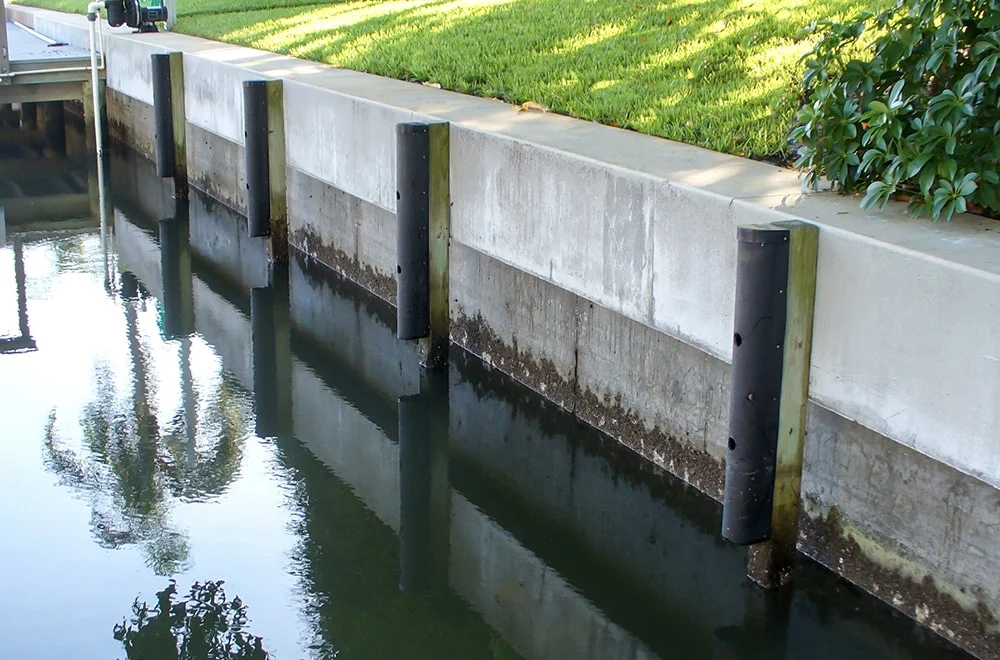Seawalls play a critical role in safeguarding Florida’s waterfront properties from soil erosion, waves, hurricanes, and other environmental forces.
Over time, even the most durable concrete seawalls or vinyl seawalls can suffer from wear and tear, leading to cracks, voids, or even seawall failure.
Deciding whether to repair or replace a seawall requires a clear understanding of the seawall repair process, the factors affecting its structural integrity, such as soil conditions and hydrostatic pressure, and the overall condition of the seawall.
At Summit Marine Development, we specialize in cost-effective solutions tailored to Florida’s challenging coastal conditions, helping to protect your waterfront home and extend the life of your seawall.
The Lifespan of a Seawall: How Long Do They Last?
The longevity of a seawall depends on multiple factors, including the materials used, construction techniques, and the stability of the surrounding environment.
Typically, a well-maintained concrete seawall or vinyl seawall can last between 30 and 50 years.
However, exposure to saltwater, tidal forces, and extreme weather events like hurricanes in Florida can accelerate wear and weakening over time.
Regular inspections and maintenance are key to ensuring your seawall continues to provide effective protection for your waterfront area.
Understanding Seawall Damage and Common Causes
Seawall damage can lead to sinkholes, structural issues, and significant costs. Recognizing the signs of damage early can help prevent further weakening and costly seawall repairs.
Signs of Seawall Damage:
Openings and Gaps: Structural openings can allow water to seep through, leading to loss of the soil behind the wall.
Leaning or Tilting Seawalls: Structural stress can cause the seawall to lean, indicating potential failure.
Soil Erosion Behind the Seawall: Soil washing away suggests the seawall isn’t effectively preventing erosion.
Voids or Sinkholes: Voids or depressions behind the seawall often result from poor drainage or hydrostatic pressure.
Water Seepage: Water leaking through openings or joints weakens the foundation, accelerating failure.
Causes of Seawall Damage:
Waves and Storms: The relentless impact of waves and storms can wear down seawalls over time.
Weak Soil Zones: Unstable ground can compromise the seawall’s foundation and overall stability.
Poor Construction: Inadequate construction techniques or low-quality materials can result in premature failure.
Hydrostatic Pressure: Pressure buildup behind the seawall from trapped water leads to fractures and instability.
Seawall Repair Options: When to Repair vs. Replace
Not every seawall needs to be replaced. In many cases, repair solutions can restore the structure’s integrity and extend its lifespan.
Here’s how to determine whether seawall repair or replacement is the best solution for your situation.
When to Repair a Seawall
Seawall maintenance is a cost-effective way to address localized damage and prevent further issues. You may need seawall repairs if you notice:
Small Openings or Gaps: These can be sealed to prevent water intrusion.
Erosion Behind the Wall: Grouting and soil stabilization can address this issue.
Loose Capstones: Securing or replacing missing capstones can restore the seawall’s structural integrity.
Minor Tilting: Installing new tiebacks or anchors can stabilize the seawall.
Seawall Repair Process: At Summit Marine Development, we use advanced techniques such as grout injection to fill cracks and stabilize soil, clincher bolts to reinforce walls, and wale reinforcement to add structural strength.
When to Replace a Seawall
If the damage is extensive or the structure is nearing the end of its lifespan, a more comprehensive solution may be required. Signs that a full overhaul or reconstruction of the seawall is necessary include:
Widespread Cracking or Deterioration: Severe deterioration indicates the seawall is beyond repair.
Frequent Seawall Repairs: If you’re repeatedly repairing the same issues, a full replacement may be more cost-effective.
Persistent Leaning or Shifting: A wall that won’t stabilize after seawall repairs likely needs to be replaced.
Significant Soil Erosion: If soil loss affects large portions of the seawall, replacement is needed to restore protection.
Seawall Materials: Choosing the Right Option
Selecting the right seawall components is crucial for durability and performance. Common options include:
Concrete Seawalls: Durable and long-lasting, making them a popular choice in Florida. However, they can be vulnerable to cracking and weathering over time, especially in areas exposed to saltwater.
Vinyl Seawalls: Lightweight, corrosion-resistant, and ideal for areas with saltwater exposure. Vinyl seawalls are a low-maintenance option that can last for decades when properly installed.
Composite Seawalls: A blend of materials designed for added strength and resistance to wear, making them a durable option for high-stress environments.
Wood Seawalls: Traditional and visually appealing, wood seawalls are often used in residential settings. However, they are more prone to rotting, warping, and damage from marine organisms, making them less durable in Florida’s humid and salty conditions.
Riprap Seawalls: Constructed from natural stones or rocks, riprap seawalls are excellent for dissipating wave energy and preventing erosion. They are an environmentally friendly option that blends well with natural landscapes, but they require proper installation and maintenance to remain effective.
Each material has its unique benefits, and the right choice will depend on factors like wave impact, environmental conditions, and your property’s specific needs. At Summit Marine Development, we help Florida homeowners select the ideal seawall material for long-lasting protection.
Cost Factors in Seawall Repair and Replacement
The cost of seawall repair or replacement varies depending on several factors:
Extent of Damage: Seawall repairs for minor breaks or voids are less expensive than addressing widespread failure.
Type of Materials: Higher-quality materials like composite or vinyl seawalls may cost more initially but offer longer lifespans.
Labor and Excavation: Accessing the site and preparing the area for construction can influence costs, especially in commercial projects.
Environmental Conditions: High water tables or unstable soil conditions may require additional stabilization efforts.
Protecting Your Property: Regular Inspections Are Key
In Florida, where hurricanes and extreme weather are common, regular seawall inspections are essential.
Professionals, like Summit Marine Development, can assess the foundation, identify any weaknesses, and recommend timely seawall repairs or replacement.
Summit Marine Development’s Commitment:
Inspections: We provide detailed evaluations of your seawall’s condition.
Tailored Seawall Repair Solutions: From crack sealing to tieback installation, we customize seawall repairs to meet your needs.
Durable Replacements: Our team uses only the highest-quality construction materials and techniques to build seawalls that last.

Ready to Protect Your Property?
Your seawall is your Florida home’s first line of defense against tidal forces, erosion, and storms. Whether you need minor seawall repairs, soil stabilization, or a full seawall reconstruction, Summit Marine Development has the expertise to handle Florida’s unique coastal challenges and get the job done right.
Contact us today for a free consultation, and let’s determine the best solution to keep your Florida property, foundation, and seawall safe for decades to come!


